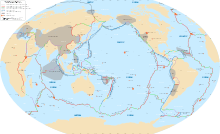Greenland Plate
The Greenland Plate is a supposed tectonic plate bounded to the west by Nares Strait, a probable transform fault, on the southwest by the Ungava transform underlying Davis Strait, on the southeast by the Mid-Atlantic Ridge,[1] and the northeast by the Gakkel Ridge, with its northwest border is still being explored.[2]). The Greenland craton is made up of some of the oldest rocks on Earth. The Isua greenstone belt in southwestern Greenland contains the oldest known rocks on Earth dated at 3.7–3.8 billion years old.[3]
The Precambrian basement of Greenland formed an integral part of the Laurentian Shield that is at the core of the North American continent. Greenland was formed in two rifting stages from the main body of North America. The first, during the Cretaceous period formed Baffin Bay. Baffin Bay is the northwestern extension and terminus of the North Atlantic-Labrador Sea rift system that started forming 140 million years ago in the Early Cretaceous epoch.[4] The Labrador Sea started opening 69 million years ago[5] during the Maastrichtian age but seafloor spreading appears to have ceased by the Oligocene epoch, 30–35 million years ago.[6] Correlations between tectonic units in Canada and Greenland have been proposed,[7] however, the pre-spreading fit of Greenland to Canada is still not accurately known.[8]
Since the closure of the North Atlantic–Labrador Sea rift, Greenland has moved roughly in conjunction with North America; thus, there are questions as to whether the Greenland Plate should be still considered a separate plate at all.[9][10] The area between Greenland and Baffin Island is, however, seismically very active, being the location of the epicenter of many earthquakes including a 7.3-magnitude earthquake in 1933. As of 2009, scientists have been unable to correlate the seismicity with particular geological structures or geophysical anomalies. It has been suggested that seismicity in the region is related to the stresses associated with post-glacial rebound.[11][12]
See also
References
- ↑ "BAFFIN BAY" (PDF). Indian and Northern Affairs Canada. Archived from the original (PDF) on 2011-06-13. Retrieved 2009-10-04.
- ↑ Denmark hopes to claim North Pole BBC News, 5 October 2004. Accessed 10 November 2006.
- ↑ Appel, Peter W.U., Hugh R. Rollinson, and Jacques L.R. Touret. (2001) "Remnants of an Early Archaean (>3.75 Ga) sea-floor, hydrothermal system in the Isua Greenstone Belt." Precambrian Research, Vol. 112, Issues 1–2, 15 November, pp. 27–49.
- ↑ Le Pichon, X., Sibuet, J. C. & Francheteau, J. (1977-03-23). "The fit of the continents around the North Atlantic Ocean". Tectonophysics. 38-3/4: 169–209.
- ↑ Roest, W.R.; Srivastava, S.P. (1989). "Sea-floor spreading in the Labrador Sea: a new reconstruction". 17. Geology: 1000–1003. doi:10.1130/0091-7613(1989)017<1000:sfsitl>2.3.co;2.
- ↑ J. C. Harrison; U. Mayr; D. H. McNeil; A. R. Sweet; J. J. Eberle; D. J. McIntyre; C. R. Harington; James A. Chalmers; Gregers Dam; Henrik Nohr-Hansen (September 1999). "Correlation of Cenozoic sequences of the Canadian Arctic region and Greenland; implications for the tectonic history of northern North America". 47 (3). Bulletin of Canadian Petroleum Geology: 223–254.
- ↑ Hoffman, P.F. 1989: Precambrian geology and tectonic history ofNorth America. In: Bally, A.W. & Palmer, A.R. (eds): The geology of North America, 447–512. Boulder,Colorado: Geological Society of America.
- ↑ Niels Henriksen; A.K. Higgins; Feiko Kalsbeek; T. Christopher R. Pulvertaft (2000). "Greenland from Archaean to Quaternary" (PDF) (185). Greenland Survey Bulletin. Retrieved 2009-10-04.
- ↑ Chadwick, B. & Garde, A.A. 1996: Palaeoproterozoic obliqueplate convergence in South Greenland: a reappraisal of theKetilidian Orogen. In: Brewer, T.S. (ed.): Precambrian crustalevolution in the North Atlantic region. Geological Society Special Publication (London) 112, 179–196}
- ↑ Peter A. Ziegler (1990) Geological atlas of Western and Central Europe. London. Geological Society. p. 125. ISBN 978-90-6644-125-5
- ↑ Stein, S., Sleep, N.H., Geller, R.J., Wang, S.-C. & Kroeger, G.C. (1979). "Earthquakes along the passive margin of eastern Canada". 6. Geophys. Res. Lett.: 538–540. doi:10.1029/gl006i007p00537.
- ↑ Allison L. Bent (2002-03-18). "The 1933 Ms=7.3 Baffin Bay earthquake: strike-slip faulting along the northeastern Canadian passive margin" (PDF). 150. Geophys. J. Int.: 724–736. doi:10.1046/j.1365-246x.2002.01722.x. Archived from the original (PDF) on 2011-07-21.
